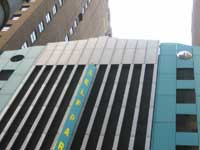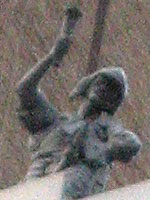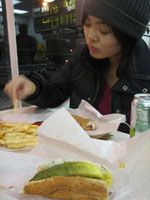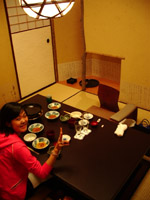Robert Moses
Topic: New York / Commack

A couple weeks ago Takotron made the long return to Long Island to visit family and friends. One positive feature of HQ LI, only applicable in the summertime, is it's proximity to the beaches. To the North is the Long Island Sound and Sunken Meadow State Park, and to the South the equally poetically- named Fire Island.
Long Island is a heap of refuse that Ice Age glaciers left at the end of their descent. Over the thousands of years since, barrier islands formed off the south shore, among them Fire Island. There are a number of geological explanations for the common presence of such islands in coastal regions. In general, they separate a main land from the ocean, with a marsh or lagoon area in between (right). Here's a summary of existing theories for their formation by some Army geologists:
PDFLong Island's barrier islands remained disconnected and remote until the 1920s and 30s, when Parks Commissioner and master builder Robert Moses began executing his dramatic developments across Long Island and New York City.

The creation of the south shore beaches is undeniably successful--he built coastal highways and bridges to make Fire Island and, to the West, Jones beach, accessible to the public. But before reporting on our Robert Moses State Park beach paradisiacal romp, let us say a few things about the controversial mastermind.
Robert Moses (left) was born in NYC, to an upper-class Jewish family, and received university degrees from Yale, Oxford, and Columbia. In the 20s he became an unnofficial advisor to Governor Alfred Smith, and later held the official position of Parks Commissioner, remaining in power through the 60s. During his reign he forever changed the shape of NYC and LI. Among the numerous NY civil accomplishments he is responsible for are the Throgs Neck, Whitestone, and Verrazano bridges; the Cross Bronx, Brooklyn-Queens, and notorious Long Island Expressways; the Belt, Northern State, and Southern State Parkways; the Lincoln Tunnel; Shea Stadium; the UN campus; and 2 World's Fairs.
Despite his immense power and influence, occasionaly his projects met their demise. One of the more fantastic proposals he drafted was the Mid-Manhattan Expressway, a 6-lane highway across Manhattan, elevated 10 stories over street level. Linking LI and NJ, it meant to connect the Queens-Midtown tunnel to the East and the Lincoln tunnel on the Jersey side. Space could be developed around and above it, with buildings accessed via elevators rising through the expressway's meridian.
By the end of his career Moses was considered by the public with mixed emotions, if not outright hostility. Undeniably, through his volition, diplomacy, and strength he was able to connect the region with his expansive network of highways, as well as build a number of beloved public parks. What he failed to do, however, was accomodate the middle and especially lower classes, whom he almost openly despised. His policies purposefully excluded mass transit, which became his perpetual nemesis.

The LIE's overpasses were consciously built at a height that prohibited public buses; The Northern State was zoned to cut through middle class property while winding around that of the rich (from whom he received questionable funds); The Cross-Bronx tore through poor neighborhoods, displacing 1530 families and isolating the South Bronx.
Moses was also responsible in part for the massive suburban sprawl of the 50s. Proposed as vacation routes for Manhattanites, the major highways to Long Island immediately became commuter routes enabling families to move further East. The LIE was developed without a called-for accompanying rail line down the meridian, enabling communities to develop outward on an automotive rather than more concentrated pedestrian scale (right). As highway traffic jams became a daily nuisance, Long Island Rail Road use was nearly halved.


But growing up my family had some great times at Robert Moses State Park, just about due south of Takotron HQ LI.

Earlier this month Agent Hotoda, RADM Townes-Anderson, and I made a special trip down there, and had a wonderful time frollicking in the sand and waves, getting knocked around by the violent, sublime, infinite Atlantic ocean (left). It was overcast and cooler that day, which held back the masses, giving us free reign over the beach (right). Notice the Robert Moses water tower in the background. The tower is a monumental marker, visible on the horizon from the Robert Moses Causway that leads to the park. At its base a traffic circle
winds around it, memorializing the car-culture Moses helped create.
More on Robert Moses:
The Power Broker: Robert Moses and the Fall of New York by Robert A. Caro
Mid-Manhattan Expressway on nycroads.comRobert Moses, The Master Builder on Newsday.comRobert Moses State Park
 Today I walked all over downtown Chicago on a quest for perfect holiday gifts. I say "holiday" because my family and friends are of various religious backgrounds, and it's semantically appropriate to be sensitive to this. I can't believe people think of this as a "War on Christmas." Being inclusive is not a move of aggression or a method of belittling Christian faith, which supposedly preaches toleration and outreach. Are these upset people sick of having to put up a false front of toleration and political correctness, and are now just blowing up and insisting on explicitly exerting their hegemonic majority as openly and straightforward as they would like? Well, "Happy Holidays" motherfuckers.
Today I walked all over downtown Chicago on a quest for perfect holiday gifts. I say "holiday" because my family and friends are of various religious backgrounds, and it's semantically appropriate to be sensitive to this. I can't believe people think of this as a "War on Christmas." Being inclusive is not a move of aggression or a method of belittling Christian faith, which supposedly preaches toleration and outreach. Are these upset people sick of having to put up a false front of toleration and political correctness, and are now just blowing up and insisting on explicitly exerting their hegemonic majority as openly and straightforward as they would like? Well, "Happy Holidays" motherfuckers. So anyway, I was shopping downtown and found myself in front of this parking garage building that I've admired from time to time before. I was always under the impression that the word "fugly" was a contraction of "fucking ugly" ("f'ugly"?), but then I recently read somewhere that referred to it as meaning "fabulously ugly," which, while a more intriguing concept, is dubious, I think. Nevertheless, this building in the loop, a Self Park garage at 60 East Lake Street, fits both of those definitions. The tire-shaped canopies are goofy but maybe amusing in a campy way. I think, from my 1 semester of experience, that architects sometimes refer to this sort of shit, when they are trying to be positive, as "whimsical." Above the "whimsical" tire-canopies are gratings shaped like sideways pointed arches through which you can see a Coke machine.
So anyway, I was shopping downtown and found myself in front of this parking garage building that I've admired from time to time before. I was always under the impression that the word "fugly" was a contraction of "fucking ugly" ("f'ugly"?), but then I recently read somewhere that referred to it as meaning "fabulously ugly," which, while a more intriguing concept, is dubious, I think. Nevertheless, this building in the loop, a Self Park garage at 60 East Lake Street, fits both of those definitions. The tire-shaped canopies are goofy but maybe amusing in a campy way. I think, from my 1 semester of experience, that architects sometimes refer to this sort of shit, when they are trying to be positive, as "whimsical." Above the "whimsical" tire-canopies are gratings shaped like sideways pointed arches through which you can see a Coke machine. 
 TAKOTRONsemester001 officially ended yesterday as I handed in my paper, "Frederick Law Olmsted and the Democratization of Landscape Theory," at 12:06PM. For the topic I researched the famous American landscape architect in relation to 2 major theoretical movements that directly influenced him, the English Picturesque of the mid to late 18th century, and American transcendentalism of the mid 19th. Both movements were rooted in our experience of rural landscapes, but had elements somewhat contrary to democracy. The Picturesque was put forth by wealthy British gentlemen who created contrived "natural" landscapes for their enormous country estates. Transcendentalism had a strong moral, even theological undertone that enveloped its aesthetic ideas, but it was too introverted and rural to be directly applicable to the urban industrial life that would grow to dominate American society.
TAKOTRONsemester001 officially ended yesterday as I handed in my paper, "Frederick Law Olmsted and the Democratization of Landscape Theory," at 12:06PM. For the topic I researched the famous American landscape architect in relation to 2 major theoretical movements that directly influenced him, the English Picturesque of the mid to late 18th century, and American transcendentalism of the mid 19th. Both movements were rooted in our experience of rural landscapes, but had elements somewhat contrary to democracy. The Picturesque was put forth by wealthy British gentlemen who created contrived "natural" landscapes for their enormous country estates. Transcendentalism had a strong moral, even theological undertone that enveloped its aesthetic ideas, but it was too introverted and rural to be directly applicable to the urban industrial life that would grow to dominate American society.








 Then I ended up going out with miss Kei and her friends Joe and Nar, and drinking quite a bit. At 3:15, in the AM, we were on our way to Golden Nugget or IHOP or something, but noticed that the Wiener's Circle was still open, so we went in, because as any local will tell you, they have about the best hot dog in Chicago. Also, their employees verbally abuse the customers in a sort of calculated entertaining way that's also heartfelt. Last night they were saying they were closing, so we better tip good. I got a hot dog with everything, and then tipped good, and they threw in cheese fries. Amazing.
Then I ended up going out with miss Kei and her friends Joe and Nar, and drinking quite a bit. At 3:15, in the AM, we were on our way to Golden Nugget or IHOP or something, but noticed that the Wiener's Circle was still open, so we went in, because as any local will tell you, they have about the best hot dog in Chicago. Also, their employees verbally abuse the customers in a sort of calculated entertaining way that's also heartfelt. Last night they were saying they were closing, so we better tip good. I got a hot dog with everything, and then tipped good, and they threw in cheese fries. Amazing.  Since thenovakids are all working hard fulltime learning how to build future cities, we've neglected our TAKOTRON NEWS page among many other of the often-overlooked pleasantries of our everyday lives, including decent meals.
Since thenovakids are all working hard fulltime learning how to build future cities, we've neglected our TAKOTRON NEWS page among many other of the often-overlooked pleasantries of our everyday lives, including decent meals. 






 A couple weeks ago Takotron made the long return to Long Island to visit family and friends. One positive feature of HQ LI, only applicable in the summertime, is it's proximity to the beaches. To the North is the Long Island Sound and Sunken Meadow State Park, and to the South the equally poetically- named Fire Island.
A couple weeks ago Takotron made the long return to Long Island to visit family and friends. One positive feature of HQ LI, only applicable in the summertime, is it's proximity to the beaches. To the North is the Long Island Sound and Sunken Meadow State Park, and to the South the equally poetically- named Fire Island.  The creation of the south shore beaches is undeniably successful--he built coastal highways and bridges to make Fire Island and, to the West, Jones beach, accessible to the public. But before reporting on our Robert Moses State Park beach paradisiacal romp, let us say a few things about the controversial mastermind.
The creation of the south shore beaches is undeniably successful--he built coastal highways and bridges to make Fire Island and, to the West, Jones beach, accessible to the public. But before reporting on our Robert Moses State Park beach paradisiacal romp, let us say a few things about the controversial mastermind. The LIE's overpasses were consciously built at a height that prohibited public buses; The Northern State was zoned to cut through middle class property while winding around that of the rich (from whom he received questionable funds); The Cross-Bronx tore through poor neighborhoods, displacing 1530 families and isolating the South Bronx.
The LIE's overpasses were consciously built at a height that prohibited public buses; The Northern State was zoned to cut through middle class property while winding around that of the rich (from whom he received questionable funds); The Cross-Bronx tore through poor neighborhoods, displacing 1530 families and isolating the South Bronx. 







 When thenovakids first began to emerge in 2002 during a semester abroad at Jouchi Daigaku, we went building-seeking on many occasions. At the top of our list was Kisho Kurokawa's Capsule Tower in Ginza, Tokyo, but we lacked the background information, navigation skills, and discipline to find it. For just a second I thought Tange's ugly brown Shizuoka Broadcasting Headquarters might be it--it's modular I guess (right). But this time, EPISODE III, we were prepared, with
When thenovakids first began to emerge in 2002 during a semester abroad at Jouchi Daigaku, we went building-seeking on many occasions. At the top of our list was Kisho Kurokawa's Capsule Tower in Ginza, Tokyo, but we lacked the background information, navigation skills, and discipline to find it. For just a second I thought Tange's ugly brown Shizuoka Broadcasting Headquarters might be it--it's modular I guess (right). But this time, EPISODE III, we were prepared, with 

 We wanted to try Sukiyaki, which is supposed to be pretty fine and very expensive. Kei's uncle recommended a place, IMAHAN. We had a private Cha-shitsu style room, into which a young woman came and cooked for us. There's a boiling broth in which she cooks various vegetables and then the thinly sliced, perfectly tender beef. You dip it all in raw beaten egg. The environment and the quality of the ingredients were incredible, and the service is traditional (and slavish). But Kei got our server to lighten up by exhibiting her purikura collection, and ultimately donating a picture to her.
We wanted to try Sukiyaki, which is supposed to be pretty fine and very expensive. Kei's uncle recommended a place, IMAHAN. We had a private Cha-shitsu style room, into which a young woman came and cooked for us. There's a boiling broth in which she cooks various vegetables and then the thinly sliced, perfectly tender beef. You dip it all in raw beaten egg. The environment and the quality of the ingredients were incredible, and the service is traditional (and slavish). But Kei got our server to lighten up by exhibiting her purikura collection, and ultimately donating a picture to her.
 Antonin Raymond was a Czech-born American architect who brought the International Style to Japan first with his own reinforced concrete house in Tokyo, completed in 1923. He arrived there in 1919, when he oversaw the construction of his mentor Frank Lloyd Wright's Imperial Hotel. Wright's hotel remarkably withstood the Great Kanto earthquake of 1923, which helped fuel the growing interest in Modern design.
Antonin Raymond was a Czech-born American architect who brought the International Style to Japan first with his own reinforced concrete house in Tokyo, completed in 1923. He arrived there in 1919, when he oversaw the construction of his mentor Frank Lloyd Wright's Imperial Hotel. Wright's hotel remarkably withstood the Great Kanto earthquake of 1923, which helped fuel the growing interest in Modern design.  Inside is FUJIYA, famous for PEKO-chan, the Milky candies campaign girl (left, with Takotron campaign girl Kei-chan), and their delicious desserts. The stairwell is bathed in light from the glass bricks, which you can see amid all the manga promo from the internet/manga cafe on the second floor (right).
Inside is FUJIYA, famous for PEKO-chan, the Milky candies campaign girl (left, with Takotron campaign girl Kei-chan), and their delicious desserts. The stairwell is bathed in light from the glass bricks, which you can see amid all the manga promo from the internet/manga cafe on the second floor (right).

 PACCHI, PACCHI, PACCHI-PACCHI-PACHHI
PACCHI, PACCHI, PACCHI-PACCHI-PACHHI

